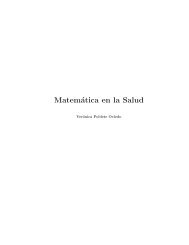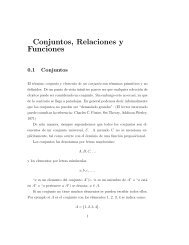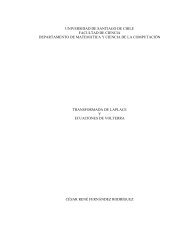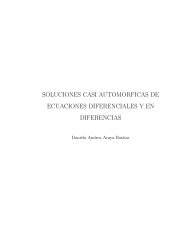Apuntes de Variable Compleja - Carlos Lizama homepage ...
Apuntes de Variable Compleja - Carlos Lizama homepage ...
Apuntes de Variable Compleja - Carlos Lizama homepage ...
You also want an ePaper? Increase the reach of your titles
YUMPU automatically turns print PDFs into web optimized ePapers that Google loves.
4.3. TEORÍA DE INDICE Y HOMOTOPÍA 27<br />
Corolario 46<br />
f (n) (z0) = n!<br />
<br />
2πi C<br />
f(z)<br />
dz<br />
(z − z0) n+1<br />
4.3. Teoría <strong>de</strong> indice y homotopía<br />
Definición 47 Sea γ una curva cerrada, <strong>de</strong> clase C 1 , y z ∈ C. Se llama Indice<br />
<strong>de</strong> z con respecto a γ al número<br />
Indγ(z) = 1<br />
<br />
2πi γ<br />
1<br />
(w − z)<br />
La expresión anterior es la fórmula <strong>de</strong> Cauchy con f(w) = 1. Reescribiendo<br />
tenemos que<br />
Indγ = 1<br />
b<br />
γ<br />
2πi a<br />
′ (t)<br />
, γ : [a, b] → C<br />
γ(t) − z<br />
Observación 48 1) El índice indica . el número <strong>de</strong> vueltas”que da la curva γ en<br />
torno a z, si z ∈ Int(γ)<br />
2) Si z ∈ Ext(γ), entonces Indγ(z) = 0 (por teorema <strong>de</strong> Cauchy)<br />
3) Si Indγ(z) = 0, entonces z ∈ Int(γ)<br />
4) Indγ(z) ∈ Z{0} si z ∈ Int(γ)<br />
Definición 49 Dos curvas cerradas cuyas trayectorias estan en un conjunto Ω<br />
se dice que son homótopas en Ω si pue<strong>de</strong>n <strong>de</strong>formarse continuamente entre sí,<br />
sin que las <strong>de</strong>formaciones se salgan <strong>de</strong> Ω.<br />
Mas precisamente, sea Ω ⊆ C y γ0 y γ1 curvas cerradas en Ω. γ0 es homótopa a<br />
γ1 si existe una función continua H : [a, b] × [0, 1] → Ω tal que H(t, 0) = γ0(t),<br />
H(a, s) = H(b, s) y H(t, 1) = γ1(t), t ∈ [a, b], en tal caso se dice que t es una<br />
homotopía en Ω entre γ0 y γ1 y se <strong>de</strong>nota γ0 ∼ γ1<br />
Teorema 50 (Invarianza <strong>de</strong>l Indice por homotopía) Si Ω ⊆ C abierto , γ0 y γ1<br />
curvas cerradas en Ω tal que γ0 ∼ γ1, entonces Indγ0(z) = Indγ1(z)<br />
4.4. Teoremas fundamentales<br />
Definición 51 Un abierto Ω ⊆ C se dice simplemente conexo si es conexo y<br />
cualquier camino cerrado en Ω es homotópico a un punto en Ω<br />
Teorema 52 Sea Ω un conjunto simplemente conexo y sea f analítica (u holomorfa)<br />
en Ω entonces existe F tal que F ′ = f







